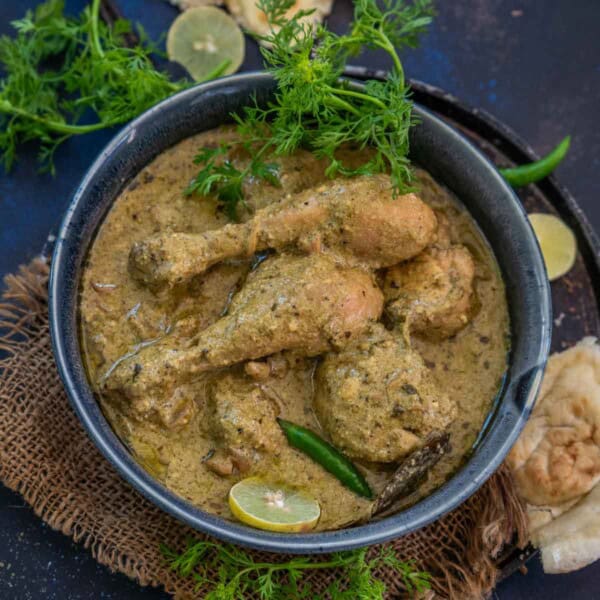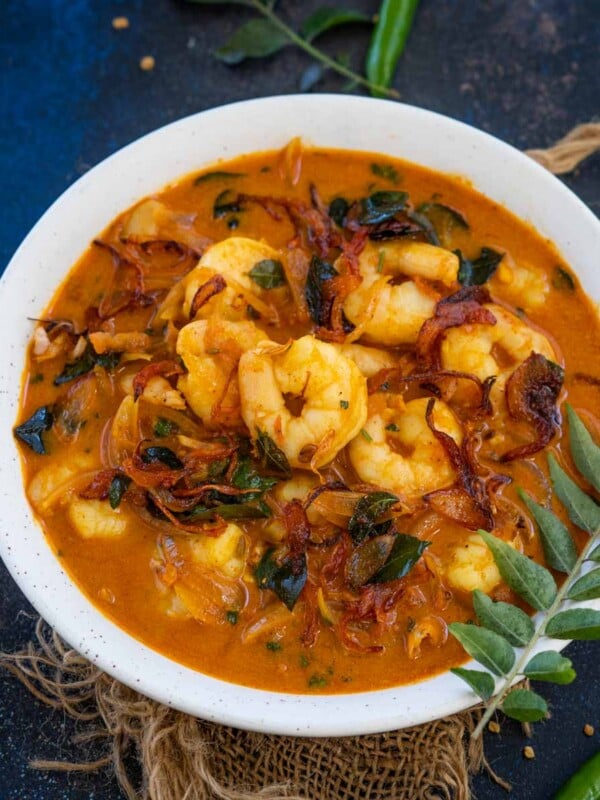on Jan 05, 2021, Updated Nov 27, 2023 Here are some more mutton recipes: Railway Mutton Curry, Punjabi Mutton Curry, Kashmiri Mutton Rogan Josh, and Bhuna Gosht. When I moved to Bangalore after getting married, my understanding of South Indian cuisine was established drastically. Being North Indian, we were only exposed to Dosa, Idli, and Uttapama in the name of South Indian food. I first encountered Mutton Kulambu at a friend’s house who invited us for dinner. And I must say it was love at first bite. She served it with Ragi Mudde, which made a fabulous combination of taste and textures. I asked for the recipe, and she obliged. Since then, I have not held back. I have made this bomb of a curry multiple times for parties and weekend meals, and it has never disappointed me. This curry tastes the best the next day as the flavors meld very well. If you have time, try to make it sometime in advance.
About Mutton Kulambu
Mutton Kulambu Curry (Mutton Kuzhambu), pronounced koo-lum-boo in Tamil, is a popular mutton (goat meat) curry from Tamil Nadu and the Chettinad region. This spicy mutton curry has an onion-tomato base flavored with a delicious paste made using fresh coconut and spices. The combination of coconut and poppy seeds gives this thin curry a distinct flavor that is just too delicious. I am sharing the methods to cook it in a traditional stovetop pressure cooker and an instant pot. Try to use Kashmiri dry red chilies, as they give a nice red color to the curry without making it too spicy. If you like to make it spicy, use a hot variety of chili (Guntur chilies). If white poppy seeds are unavailable, you can replace them with cashew nuts or melon seeds. This curry tastes best when made using fresh coconut. To save time, you can buy already grated frozen fresh coconut. You will find it in the freezer section of any Indian grocery store. However, if fresh coconut is not available, use dry coconut in its place.
For The Curry
To make this Chettinad mutton gravy, you will need bone-in goat mutton (or lamb), oil, onions, curry leaves, green chilies, fresh tomatoes, salt, turmeric powder, and Kashmiri red chili powder. You can use boneless mutton, too, but I feel the bones give the curry a lot of flavor, so I highly recommend using bone-in mutton. Use gingelly oil or peanut oil for an authentic flavor. You can also add a teaspoon of coriander powder and other spice powders to thicken the curry. You can add ½ cup of coconut milk once the curry is ready and bring the curry to a gentle simmer.
1 tablespoon white poppy seeds (or cashew nuts) 6-8 whole dry red chilies (remove the stalk) 1 teaspoon cumin seeds 1 teaspoon fennel seeds 2-3 cloves 1-inch piece of whole cinnamon stick 2 teaspoon whole black peppercorns 1 teaspoon chopped garlic 1 teaspoon chopped ginger ½ cup chopped onions 2 tablespoon chopped or grated fresh coconut
Add ½ cup of water and blend to make a smooth paste. Scrap the sides of the blender a few times while blending. Set aside. Note – You can dry roast the spices before grinding for more robust flavors. Once the oil is hot, add the following ingredients.
1 cup chopped onions 10-12 curry leaves 3-4 green chilies (slit into half)
Cook until the onions are softened and light golden brown, stirring regularly. This will take 6-8 minutes. Add 1 cup chopped tomatoes and 1 teaspoon salt and cook for 2-3 minutes. Stir frequently. Add ½ teaspoon turmeric powder and 2 teaspoon Kashmiri red chili powder and cook for another minute. Now add the ground masala paste and 1 lb (500 g) bone-in mutton pieces (cut into 1 and ½-inch chunks) and stir well. Clean the jar using water and add the water to the pressure cooker to prevent the masala from being wasted. Add 2 cups of water to the cooker and close the lid. Pressure cook for one whistle on high heat. Then, set the heat to low and cook for 25 minutes. Remove the cooker from heat and let the pressure release naturally. Open the lid of the cooker once the pressure is released. Check for salt and add more required. Adjust the gravy consistency by adding more water if needed. Garnish with chopped cilantro (fresh coriander leaves) and serve hot. Note – If the mutton is not tender, pressure cook for another 8-10 minutes.
Coriander Chicken Curry (Dhaniya Chicken Curry)
Coconut Curry Chicken
Kerala Shrimp Curry (Chemmeen Curry)
Malabar Chicken Curry















